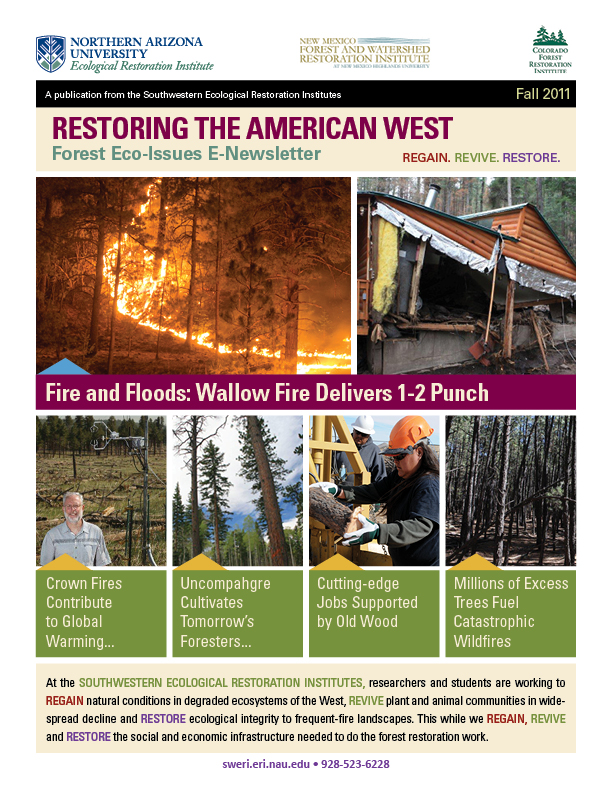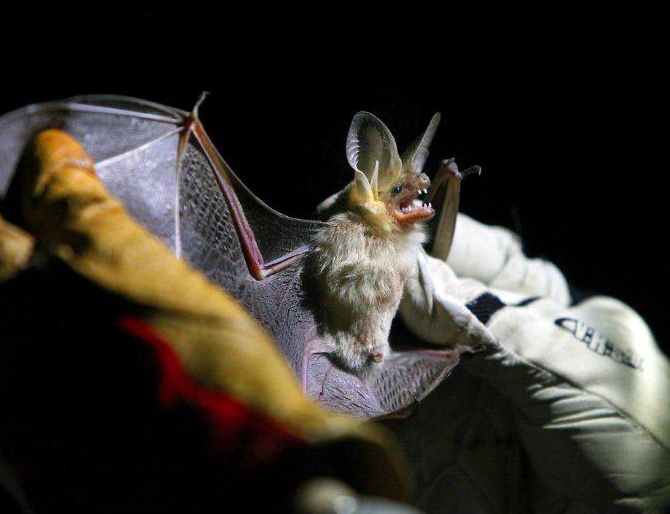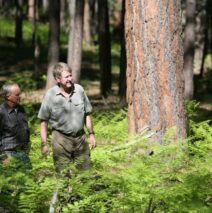Ranching, Reading and Writing
From establishing the institution, elevating it to university status, creating a world-renowned forestry school and Ecological Restoration Institute, advancing research opportunities and maintaining the vision of a premier undergraduate residential experience, the Babbitt family and Northern Arizona University have built a world-class commitment to stewardship of Arizona’s landscapes and communities. “The single most important thing that happened in the history of NAU regarding the Babbitt family was (the late) John Babbitt’s determination to bring the school to a university level,” said former Arizona Regent Norm Sharber. “Without the word ‘university’ on your name, it was difficult to obtain certain grants or attract top faculty. John fought some heavy battles in the legislature.” The quiet, reserved state senator served in the Arizona Legislature from 1945 to 1948 and has been recognized for his ability to make things happen. But the Babbitt family’s impact on NAU and education began long before that. In the late 19th century, the Arizona Territory was a rough place. The Arizona Territorial Legislature decided a reform school was needed to house and rehabilitate lawbreakers. George Babbitt, a gregarious, generous and popular businessman, was appointed president of the board looking into such a facility. “George probably knew a reform school was not what Flagstaff wanted, but moved forward to establish the building with the idea that the legislators’ minds could be changed about what kind of school would actually be created,” said James E. Babbitt, nephew of the late state senator with the same name. Indeed, the reform school did not materialize but the Northern Arizona Normal School did. It was a college to teach teachers. It started in 1899 with the red sandstone building now known as Old Main and later became the Arizona State Teachers College at Flagstaff. George and other leaders of the day likely believed the business of education would have a positive impact on the economy as well as on the culture of the town they were creating. GOOD FOR BUSINESS, TOO George died in 1920, but other Babbitts then championed the cause of higher education. As a state senator, James E. “Jim” Babbitt was considered one of the most influential democrats in the county. In 1936 he helped establish master’s degrees at the colleges in Flagstaff and Tempe (now Arizona State University). This move boosted enrollment in Flagstaff as credential-seeking teachers spent their summers on the mountain campus. In 1944, Jim died during a hunting trip. John was called to finish the Senate term. He was elected to another term and became Senate President. From the Senate, he went on to spend 16 years on the Arizona Board of Regents. “John Babbitt was one of the forces getting Coconino County behind the Tempe college becoming a university. He thought if we were supportive of them, they would be supportive of us. And it worked out,” said 12th NAU President Gene Hughes. “I just know that behind the scenes was John Babbitt thinking, ‘This is going to be good for Flagstaff.’ He had that vision, for the Babbitt businesses, the livestock industry and the community. John also led the effort that created the School of Forestry in 1958. SERVICE AS REGENTS Two other Babbitt family members served as regents guiding the state universities in what became known as The Babbitt Chair. Norm Sharber, a respected businessman married to Dr. Rayma Sharber (daughter of arts patron Viola and Babbitt Ranches President Joseph Babbitt) was appointed in 1965. He and NAU’s 11th President J. Lawrence Walkup would walk the campus together wondering how to accommodate the thousands of students headed their way. Those conversations...
Read MoreBats Offered Alternative to Haunted Houses
Bats Offered Alternative to Haunted Houses This time of year we often associate bats with haunted houses, but houses don’t have to be haunted to attract these creatures of the night. Wildlife biologists say the large, standing dead ponderosa pine trees that many bats prefer are not abundant in our Southwestern forests anymore. So instead of crawling under the loose bark of snags to roost or raise their young, bats may be choosing to live with you, under the eaves of your home. To solve this shortage-in-bat-housing problem, Northern Arizona University School of Forestry graduate student Liz Mering is introducing bat condominiums to the forest neighborhood. “We have two kinds of artificial roosts that mount onto the trunks of large trees and mimic the exfoliating-bark characteristics of dead, old ponderosas pines. One is made of wood and looks like a one-foot by one-foot wedged box. The other is made of resin. It’s molded and painted to look like bark.” Mering has posted 104 artificial roosts in trees around Flagstaff in the last two years. Half are wooden; half are resin. She says it’s too early to tell which kind the bats like better, but wildlife biologists prefer the resin roosts. They are made of the same material you find in boats, so they’re durable, lasting as long as the bats themselves, up to 30 years in the woods. And because they look so much like the bark of a ponderosa pine, they are fooling both the bats and their predators. Unfortunately, they are also expensive, about $50 each. Noting the importance of bats in the ecosystem, the Forest Service has purchased 50 of these to ofer bats more habitat. “Bats have gotten a bad reputation because people often associate them with rabies,” says Red Rock Ranger District Wildlife Biologist Janie Agyagos. “But less than half of 1 percent of the bat population actually carries the rabies virus. Instead, bats provide many benefits to the forest.” Those benefits include fertilizing the soil with their guano, pollinating certain plants, and the big one, eating a lot of insects. Of the 28 bat species squeaking and echo-locating across Arizona’s dark skies, 20 different kinds live in northern Arizona. Most weigh less than half a Hershey’s chocolate bar, but these ravenous nocturnal creatures are eating far more than their weight in pests. “One bat can eat 600 mosquitos in an hour,” says Agyagos. “The desert pallid bat found in Sedona can pick up scorpions and millipedes off the ground and fly away with them.” Keeping up with that appetite is exhausting, so finding a safe place to rest is critical to the bats’survival. “We have a lot of trees in the forest, but not a lot of big trees,” says NAU School of Forestry Wildlife Ecology Professor Dr. Carol Chambers. “The bats we are studying are using trees with 25- to 30- inch diameters. With human-caused changes to the forest structure during the last century, we don’t have as many big, old trees as we once did, trees that will die and become bat habitat. While forest restoration efforts eventually will result in more big old trees, we’re hoping to be able to provide viable bat habitat in the meantime.” By attaching a large bag that looks like a wind sock to the bat boxes, Mering is able to briefly capture the bats when they leave the roosts and examine them for disease and gender. “We’ve gotten a lot of use based on mostly non-reproductive single bats. We’re hoping in a few more years we’ll get more use as many bats find them and remember them.” If female bats set up maternity colonies and begin raising their pups in the artificial bat homes, researchers say they’ll have found a...
Read MoreResearchers Study in the Land of the Giants
In a place called Barney Spring, Ecological Restoration Institute researchers are wading through a sea of waist-high ferns to study among the giants in a rare, old-growth forest. Ecologists have been predicting the disappearance of most old-growth ponderosa pines within our lifetime. In the West, where the forests have been heavily logged and much younger trees now crowd the landscape, old-growth pines almost can be considered an endangered species. But on the Mogollon Rim south of Flagstaff, these vulnerable giants still live in abundance. "It's humbling to look up at these trees. You feel so small," said Northern Arizona University forestry graduate student Eryn Schneider. "Many of these trees are 150 feet tall or taller, the upper range of ponderosas in this region." But despite their impressive height, it's their more impressive age that has researchers so interested. "Some of these trees easily could be 400 years old. Maybe 450," said ERI Executive Director Wally Covington. This particular tract of land, once owned by a railroad company, is now the private property of contractor Warren Smith. Somehow it has dodged the ax of loggers and the burn of catastrophic wildfire. It now serves as a 160-acre window into the past, the kind of window Covington and other ecologists have always wanted to peer into. "To have these old-growth trees as kind of the anchor for restoring natural biodiversity, natural beauty and the wildlife habitat of the area is really unique," he said. It's unique for researchers trying to reconstruct what the forest looked like before pioneers arrived and began making changes to the ecosystem through activities such as logging, grazing and fire suppression. "When you have a stand where you can actually look back far enough to see what it was before settlement, it's really helpful in establishing what a healthy system should look like," said Schneider. This summer, Schneider is identifying every old-growth tree out there. By recording the age, the number of pre-settlement trees per acre and their pattern on the landscape, she's hoping land managers will be able to use this information to recreate the natural forest structure and restore the ponderosa pine forest to a healthy condition. "I just fell in love with this property," said Smith. "I feel so blessed that such an area still exists where you can see what the forest would have been like before logging and before fire damage." But Smith knows this area may not exist as it is for long. Last summer's Taylor Fire came dangerously close to his land, torching and destroying many tall trees nearby. That sparked his attention. Since then, Smith has invited researchers out. He's learning what young trees to remove and how to clean up a century's worth of matchstick-like pine needles so these old giants can thrive and once again live with fire. Bonnie Stevens is the Ecological Restoration Institute at Northern Arizona University Program Director for Public Education and Information. Link to The AZ Daily Sun...
Read More




